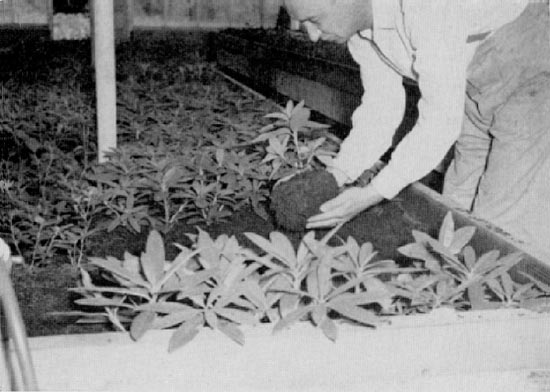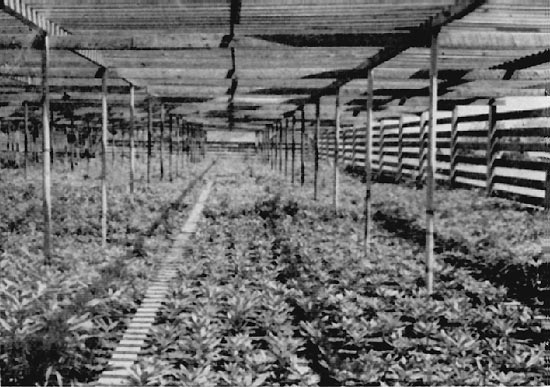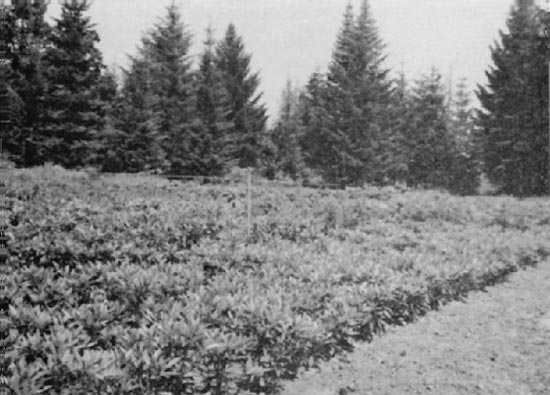QBARS - v5n3 The Propagation of Hybrid Rhododendrons from Cuttings
The Propagation of Hybrid Rhododendrons from Cuttings
P. H. Brydon
(Continued from the last issue)

|
|
Removing rooted cuttings from the benches
preparatory to removal to the lath house. Henny and Brydon, Inc. Brydon photo |
Cutting Out Rooted Cuttings
As was explained in the last paragraph, the time of "cutting out" the rooted cuttings may vary from December to February and in the case of slow rooting or late inserted cuttings, this operation may extend into March and April. After a propagator has been in the business for some years, he is able to tell with a fair degree of accuracy just when the cuttings are ready to cut out by looking at the foliage, although the surest method is to dig down with a knife and "see for oneself." The illustration in the April 1951 issue shows a rooted cutting being removed from the medium. You will note that the root ball is solid and held together by the mass of hair like roots. In this condition they become established quickly and make grand plants. Any "weak sisters" which have a poor root system are usually potted and plunged into the frame, or, if they are not rooted but still fresh and with foliage intact, they are re-inserted into the bed for future planting. I explained in the first chapter of this article that the middle bench of the propagating house was left empty to receive the rooted cuttings as they were cut out. These middle benches are filled with a good grade of horticultural peat moss to the depth of about 6 inches and it is into this medium that the cuttings are planted. The distance apart will vary with the variety, for example, 'Anton Van Welie' is usually fat around the base and broad across the shoulder whereas augustinii is quite a slender fellow and can be crowded into less room. Generally speaking, the rooted cuttings are placed about 7 or 8 inches apart, center to center, which allows them sufficient room to make their primary growth before going out doors. Small varieties such as 'Bric-a-brac', 'Blue Tit', 'Cilpinense', etc. are better off in flats for the first move whence they are moved into benches and then into the open. Some growers prefer to pot all the rooted cuttings and transplant them from 2-1/2" pots into the beds. It has been our experience that this method tends to prevent the formation of a sturdy root ball with a consequent reduction in top growth. Furthermore, rooted cuttings grown on in pots do not become as quickly established as bench grown plants. Temperatures in the glass house, after cutting 'out, should be around 55 to 60 at night. This gentle heat promotes top growth and encourages the apical buds to push. Should the young plant push only one bud, then it is promptly broken out with the forefinger and thumb to force the resting buds in the axils of the leaves to grow and form a primary framework of several branches. The aim of the grower is to obtain three or more growths in the early stages in order to form a framework of evenly spaced branches upon which to build a well formed and balanced plant. In some varieties, there is a second growth formed in the glasshouse preparatory to transplanting out of doors, in which case the elongating buds are pinched out once again so that the secondary branches may number six or more the first year of growth. It is not usually necessary to feed the young plants at this stage, and most varieties are unusually sensitive to fertilizer in any shape or form. If they are cut out in February or March, the middle benches should be almost solid with roots by the end of May or early June when the houses are given as much air as possible in preparation for the first move to the out door beds.

|

|
|
Newly planted cuttings growing in partial shade.
Henny and Brydon, Inc. Brydon photo |
Two year old rhododendrons growing in the open
Photo: Henny and Brydon, Inc. |
First Transplanting:
The first move out of doors is into made up beds under lath shade. The lath house is about 8 feet high and built so that the laths are their own width apart and running at right angles to the sun's path across the sky thereby giving the plants a moving shade. The distances apart in the beds is again determined by the variety, although in some instances it is deemed advisable to leave the plants for two years, and then the distance is increased fifty percent to provide enough room for two years growth. At this stage, overhead sprinklers are a necessity and the most practical method for maintaining the humidity is to install the sprinkler on the roof of the lath house. On hot days the streams of water are broken into a fine mist as they fall on the laths and the temperatures beneath are reduced as much as ten to fifteen degrees. Pinching of young growing buds is continued wherever it is thought necessary to increase the number of branches and a sharp look out is kept for insects, particularly thrip. A preventative spray of D.D.T. combined with Black Leaf "40" is applied to keep the plants free of both thrip and aphids. Applebait, in one of the proprietary forms, is applied once or twice during the season as a precaution against the adult Strawberry Root weevil which can be so destructive if allowed admittance to the propagating areas.
The move from the lath houses to the open field is carried out the spring following the move from the glasshouse, unless the plants were planted sufficiently far apart with the idea of leaving them in the same position for two years, in which case transplanting is delayed one more year. The cultivation from then on is much the same as has been described innumerable times in these bulletins. I trust that those of my readers who are amateurs and grow rhododendrons for pleasure might be induced to "try their hands" at their increase via the propagation by cuttings. Apart from the breeding of rhododendrons, this phase of their culture is the most fascinating of all.
In conclusion, I should like to leave you with a thought expressed by the late J. G. Millais. "In the course of years observation teaches us so much that at first was hidden, we can but marvel at the Beauty and Simplicity of things formed by the Creator...Plants, birds and mammals are beings - in some way - more worth studying than man, because in our contact with our fellow-creatures we so often never get beyond the crust... But into any section of Nature we can dive headlong without fear, knowing that we are explorers in a new field of thought and infinite pleasure, where Truth alone holds good and there are no affectations."
